Raphael Montañez Ortiz: Chopping Up the Classics
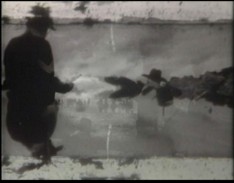
Cowboy and “Indian” Film
UCLA Film & Television Archive and Los Angeles Filmforum present
Raphael Montañez Ortiz: Chopping Up the Classics
Friday,December 8, 2023, 7:30 pm
At the Billy Wilder Theater, Hammer Museum, 10899 Wilshire Blvd., Los Angeles, CA 90024
Full information at https://www.cinema.ucla.edu/events/2023/12/08/raphael-montanez-ortiz-program-1
In-person:
Introduction by Chon Noriega, Distinguished Professor, UCLA School of Theater Film and Television. Video introduction by artist Raphael Montañez Ortiz.
Admission is free. No advance reservations. Your seat will be assigned to you when you pick up your ticket at the box office. Seats are assigned on a first come, first served basis. The box office opens one hour before the event.
Raphael Montañez Ortiz’s film, music and video art represent a missing link in the history of experimental media in the post-WWII era that helped redefine the idea of modern art after Abstract Expressionism. Born in 1934, Ortiz is a key figure of the 1960s international “Destruction in Art” movement, U.S.-based Guerrilla Theater and Latino art (including as founder of El Museo del Barrio). His object-based work is in the permanent collections of major U.S. and European art museums. But Ortiz’s turn to destruction in art started by way of film in the late 1950s with his use of ritual and shamanic approaches to the destruction of 16mm films sold for home viewing. These recycled films are concurrent with similar work by Bruce Conner and other avant-garde filmmakers around the world, but they signal a distinct alternative to traditionally modernist work relying on classical music composition and “diagnostic” editing as a critique of media culture. Ortiz extended his work from ritual destruction to performance-based editing in the 1980s and 1990s through what he called “scratch videos.” His extensive media collection — archived at UCLA — includes footage documenting the emergence of performance, installation art and experimental music in New York City. This two-night program surveys the full scope of his media art since the late 1950s.
Series curated and notes written by Chon Noriega, Distinguished Professor, UCLA School of Theater Film and Television.
Program 1: Taking an Axe and Hole Punch to Celluloid + Filming Destructions
Part 1: Taking an Axe and Hole Punch to Celluloid
In the late 1950s, Raphael Montañez Ortiz purchased 16mm one-reel shorts sold at local drug stores and camera shops for home viewing. Most came from Castle Films, which marketed excerpted scenes or re-edited sequences from newsreels, documentaries and Hollywood feature films. For Ortiz, who grew up listening to radio programs, these one-reel films not only brought mass media into the home, as did radio and television, they were also physical objects one could appropriate, break down and remake into something else. In this regard, he was very influenced by Dada, Duchamp and the Readymade. But he also added his own evolving interest in non-Western ritual, the unconscious and destruction within art practice. Note: to provide historical context, the source will be screened before Ortiz’s film.
Total running time: approx. 100 min.
“Building an Art Community from the Ashes of Destructivism” by Ela Bittencourt, Hyperallergic review of museum show of Ortiz in 2022, at https://hyperallergic.com/753268/raphael-montanez-ortiz-el-museo-del-barrio/
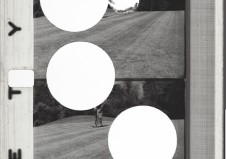
Golf
Golf
U.S., 1957, 16mm, b&w, 1 min. Premiere of restored print. Restoration funding provided by the National Film Preservation Foundation. Restored by the UCLA Chicano Studies Research Center in cooperation with the UCLA Film & Television Archive. Laboratory services provided by BB Optics, Inc.
The film is a ritual destruction of a 1940 sports documentary that follows three top American golfers from Pebble Beach to Augusta, Georgia. Ortiz punches holes in the film using a revolving hole punch plier with different punch sizes. As he explains, "Golf was the result of my attempt to make space in the frame, space that was non-film space, that would take over the film space. With each random hole punch, I chanted, ‘Emptiness is fullness.’” Ortiz then excerpted the final 70 seconds of the film, which have an “instructional” quality to them emphasized by veteran radio announcer Alois Havrilla’s narration.
Preceded by the source: Follow Thru (1940), from the series Sportbeams: Home Movies of the Champions from Every Field of Sport (Official Films). 16mm, b&w, 9 min.
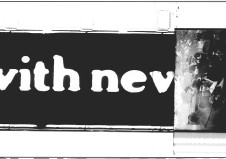
Cowboy and “Indian” Film
Cowboy and “Indian” Film
U.S., 1957-58, 16mm, b&w, 2 min. Premiere of restored print. Restoration funding provided by the National Film Preservation Foundation. Restored by the UCLA Chicano Studies Research Center in cooperation with the UCLA Film & Television Archive. Laboratory services provided by BB Optics, Inc.
The film is a ritual destruction of a Castle Films excerpt of a standard “Cowboys vs. Indians” scene taken from Anthony Mann’s Winchester ’73 (1950). Ortiz used a tomahawk to hack away at the 16mm film print before placing the shards into a medicine bag and shaking it while chanting. As he explained, “I was imitating Indigenous ritual to find my place in it.” He then pulled out individual pieces, splicing them together, regardless of orientation. Ortiz conducted this ritual twice, using two prints, and then excerpted a section from one of the ritual assemblages as his final work.
Preceded by the source: Guns of the West (Complete Edition, Castle Films, excerpt from Winchester ’73 [1950]).
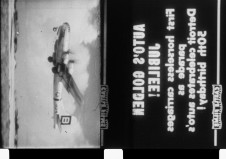
Newsreel
Newsreel
U.S., 1958, 16mm, b&w, silent (with composition added), 2 min. Premiere of restored print. Restoration funding provided by the National Film Preservation Foundation. Restored by the UCLA Chicano Studies Research Center in cooperation with the UCLA Film and Television Archive. Laboratory services provided by BB Optics, Inc.
The film is a ritual destruction of a Castle Films newsreel compilation for 1946 with pieces randomly selected and spliced together. There are two sound versions of Newsreel: one using Ortiz’s destruction composition "Accelerated Zen Prayer" (1968), and another using his 1989 Piano Sacrifice Ritual at Kunst Scharifeh-Mühle in Köln, Germany.
Preceded by the source: News Parade of the Year: 1946 (Headline Edition [?], Castle Films, b&w).
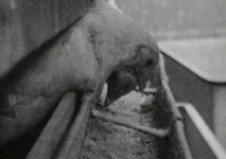
Henny Penny: The Sky is Falling
Henny Penny: The Sky is Falling
U.S., 1958, 16mm, b&w, silent (with composition added), 8 min. Premiere of restored print. Restoration funding provided by the National Film Preservation Foundation. Restored by the UCLA Chicano Studies Research Center in cooperation with the UCLA Film & Television Archive. Laboratory services provided by BB Optics, Inc.
Ortiz shot the film in 1958 in a chicken slaughterhouse in Brooklyn’s Coney Island area of New York City. The audio is from Ortiz’s Destruction Piano Concert at Duncan Terrace, London, England, as part of the Destruction in Art Symposium in 1966.
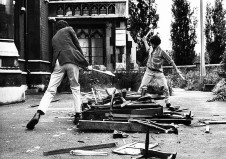
Piano Destruction Concert, London, England
Piano Destruction Concert, London, England
U.S., 1966, DCP, b&w, 5 min.
U.S. TV reports on Ortiz piano destruction concert at the 1966 Destruction in Art Symposium (DIAS) in London that was organized by Gustav Metzger. This staged performance provides a manifesto of sorts in line with Ortiz’s “Destructivism: A Manifesto” (1962) and other writings at the time.
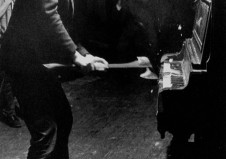
Piano Ritual Sacrifice
Piano Ritual Sacrifice
U.S., 1967, DCP, b&w, silent (with audio added), 20 min.
Following DIAS, Ortiz returned to New York City, staging a series of Destruction Rituals, including Henny Penny Piano Destruction Concert with Paper Bag Destruction at his studio near The Hotel Chelsea. The sacrifice involves a chicken and an upright piano. The edited footage is nonlinear, jumping around in time, while the recorded audio is linear and includes a voice-over narrative of the event (possibly for radio broadcast).
Destruction Room
U.S., 1967, Digital file, b&w, silent (with audio added), 10 min.
Documentation of Ortiz’s piece for 12 Evenings of Manipulations at Judson Church, which he co-organized with Jon Hendricks. Other participating artists included Jean Toche, Allan Kaprow, Al Hansen, Carolee Schneemann, Lil Picard, Kate Millet, Nam June Paik, Charlotte Moorman and Ken Jacobs.
Excerpt from Past Life Regression
U.S., 1979, DCP, color, 10 min.
This video is one in a series of recorded sessions directing participants through previous lives. Ortiz would use these for his dissertation, Towards an Authenticating Art (1982). This work represents a shift in Ortiz’s thought about destruction in art, from a focus on actions and objects within an arts space to a focus on the human body as the site of art itself.
